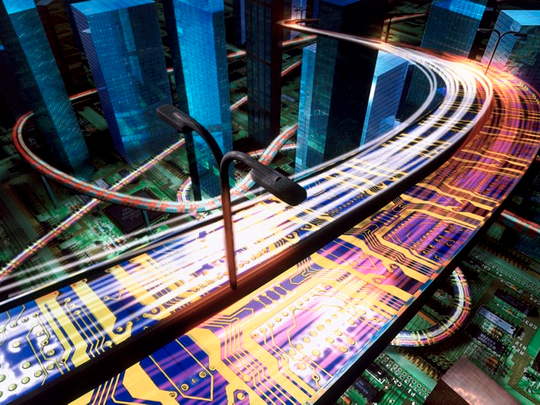
The latest in car tech usually grabs attention, while innovations in roads tend to take a backseat. But without good roads, great cars would be hobbled contraptions.
As it turns out, there are many exciting developments rolling out in road — and rail — tech that will radically change how we travel from Point A to Point B. It’s estimated that the Earth is covered in over 33 million km of road — enough to wrap around the equator 833 times. So road-related innovations have many miles to go before they, well, reach the end of the road.
IoT roads
Britain’s first internet-connected road, the A14, is being lined with sensors that monitor traffic by hooking up with smartphones in passing vehicles. The data is used to smoothen the flow of traffic and warn drivers of potential hazards. Tech website WT Vox reports that, at a recent meeting, Department for Transport Minister John Hays said Britain is at a turning point in the history of road building. Future constructions will need not only engineers but also software programmers, robotics experts and nanotechnologists. "The craft is about to be transformed by the digital revolution," said Hays. "Our roads, bridges and tunnels are joining the internet of things (IoT)." Roads will also be built with self-healing materials. If repairs are required, an automated alert is sent.
Car to car talk
Future cars will not only chat with the roads but also with each other — discussing their plans for the journey ahead, and protesting loudly if they get too close for potential accidents. Currently, connectivity in cars is largely infotainment-oriented, pulling audio streams, weather updates and entertainment content. But as the software services company Wipro notes in its April report, Wipro Insights, companies like GM, Siemens, Toyota, BMW, Daimler Chrysler, along with the Car 2 Car Consortium are investing substantially in vehicle-to-vehicle (V2V) communication. This tech will help overcome blind spots, reduce accidents and warn cars of dangers ahead — the range of V2V is up to 1km. The US National Highway Traffic Safety Administration has been running V2V trials for the past three years, and is formulating a universal standard. The tech is expected to be made mandatory by 2017, and will see widespread adoption globally, and especially in the Middle East, where high-speed traffic is a common sight.
Sunny roads
Imagine driving over solar panels layered with bulletproof glass that can handle 125 tons of weight and provide enough traction to stop vehicles going over 100kmph. The road will also come baked with heating strips to melt snow, LEDs to display divider lines, signage and alerts, and channels for optical fibre and data pipes to run alongside. The concept, from US-based Solar Roadways, has certainly piqued interest — on a crowdfunding site, the company raised over $2 million (Dh7.3 million). Plus, it has bagged various US government grants. Solar Roadways claims that if all the paved roads in the US — about 20,000 sq miles — were replaced by this tech, it would generate enough electricity to power the entire country. And with its sunny climate, the Middle East could be a potent market for this.
Charge as you go
Europe is turning out to be a cosy home for electric vehicles, although they remain limited by the short distance they can traverse before needing a recharge. One solution is to have charging points at regular intervals, but a car takes time to charge. One fascinating idea, however, is to use the road itself to charge the electric vehicles passing over it. Smartphone users are already familiar with wireless charging, where you place the phone on a charging base for induction to transfer energy. CNBC reports Volvo is working with the Swedish Transport Association to convert an experimental stretch of road into a rolling battery charger that would be used by specially equipped electric buses for recharging. Similar tests are under way in the US, Italy and South Korea.
Some more for the road
In the Netherlands, experiments are under way on a temperature-sensing road that uses colour-changing dynamic paint to indicate weather conditions. The country is also trying out a glow-in-the-dark road, where a special paint absorbs solar energy through the day glows at night. Elsewhere, researchers are trying to convert the vibrations of passing vehicles into electricity, and to harness the draft produced to passing vehicles to power street lights. And on roads less travelled, intelligent street lights will turn on only when a vehicle passes by.
Floating forward
Speed may thrill, but to achieve it trains have to battle major drags like weight, air resistance and friction. But what if friction and weight were to be taken out of the equation? Maglev tech magnetically levitates the train and use repulsive forces to send it hurtling at speeds in excess of 300kmph. The rides are smoother too, since the train is literally floating on air. Maglev trains are already in service in China and Japan, while South Korea is building one for its Incheon airport, and an upcoming Japanese version will cover around 320km between Nagoya and Tokyo in a mere 40 minutes.
Moving platform
No matter how fast trains can go, they still have to stop at stations to pick up passengers. But what if the train did not stop, and instead the platform caught up with it and passengers simply hopped in and out? A parallel would be mid-air refuelling, where both planes move together at constant speed. So from a passenger’s perspective, the train is actually stationary. The idea, called Moving Platforms, has been proposed by UK-based design firm Priestmangoode, and as its director Paul Priestman told Railway Technology magazine, "The world is going to be a very different place in ten to 20 years and we have to think of alternative ways to travel."
On track with other tech
Many countries have two gauge — the distance between the rails — tracks, while Japan has four. Instead of trying to globally standardise the gauge, an elegant solution is to make trains universal with a flexible undercarriage that automatically adjusts the gap between parallel wheels to suit the track under it. So, in theory, the same train can run anywhere in the world. Elsewhere, the String Transport System imagines riding high-speed trains on relatively cheap high-tension wires — this is apparently cheaper than existing monorail systems. Meanwhile, the US-based SolarBullet project, currently in R&D, hopes to power trains using solar panels embedded in the tracks, while the T-Box project imagines that turbines under the tracks will harness wind energy generated by trains hurtling above. Finally, as with future cars and trucks, future trains too will lack a once vital element — the driver.








